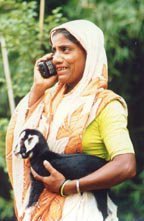Rural India: Vegetable vendors selling CDMA..
Similarly, "The Tata group company, which sells its services under Tata Indicom brand, has started selling RCVs through pan and medical shops and hotels among others, apart from its 1,700 True Value outlets in the countries."
A challenging initiative indeed! However, the most interesting element of the strategy is that
“Reliance intends to train the owners of vegetable and grain mandis to demonstrate and sell the product, and to provide after sales services.”
How do you use these channels to market your products and services? A natural technique that would be pertinent here would be the word-of-mouth (WOM) marketing. But, as most of the models on WOM infer, WOM would be more effective through an expert than a novice (I intend to post an entry on the relevant WOM model soon!).
The question is ….what and who qualifies as an expert? Definitely, the context is critical for someone to be called an expert.
Crudely put, consumers would be receptive to the opinion or predicament of an individual who has demonstrated experience and has a credible background to support his arguments. Obvious example…readers would add more credence to marketing trends predicted by Tom Peters or Laura Ries than to this pseudo-marketer p-obsessed RBTP blogger! Background, experience and relevance provide credence in every marketing communication and any form of the business.

(1) Keeping this in mind, a vegetable vendor would be an expert in vegetable prices, commodity trading and futures at the most; cooking gas distributors would be experts in cooking gas, recipes and home appliances at the most; cable operators would be experts in channels, installation of cables and satellite connectivity at the most…
Where does mobile telephony come into picture? I understand that new competencies can be developed and training is a big facilitator. But, there has to be some relation and established “credibility” associated with it, as I mentioned above. In this scenario, how convincing would be these vendors be when it comes to selling CDMA phones to customers?
(2) Another problem with vendors is that most of them are from a lower caste in the village. Though caste system is too archaic a concept in the urban sections of the society, it is still a big differentiating factor in the rural part of India and very less can be done to think of a workaround. (Consider the sanchalak in the e-choupal framework who is taken from the upper caste of the villages). This is another factor that could act as a detriment towards making vendors as salesmen!
(3) Thirdly, another factor that I read in a research paper, on vendors as entrepreneurs..

Like any other entrepreneur or businessperson, street vendors need capital. Unfortunately, given the widespread perception that vendors are,at best, a “nuisance” or, even worse, “thieves” or “vagrants,” banks tend to disregard their need for capital. The result is that vendors have to borrow from private moneylenders or wholesalers. Vegetable and fruit vendors, for instance, begin their business at dawn, when they buy their wares from wholesale merchants or middlemen in the wholesale markets. Since most of these women have little working capital, they are forced to borrow at very high interest rates – around 10 per cent per day on capital advanced.
Thus, the stated can be inferred! Yes, the distribution channels are fine and these professionals can facilitate (and only that, probably) sales and provision of products to the consumer. But communication? Marketing? After-sales services? Doesn’t seem to be too promising an idea.
Its easy to criticize I know. But let me attempt to suggest some plausible alternatives...
 One important interface or touch point in any rural setup is the parchuni or the grocery shop. Since the retailer is considered to be the rep of the city and the messenger of the urban culture, he would be listened to. This is considering the “emulative” trait of the rural consumer, where most of the rural youth have a strong sub-conscious urge to emulate their more sophisticated and well-off counterparts! (Again, if the vegetable vendors and the grain vendors route from the grocery shop, it would attach some credence)
One important interface or touch point in any rural setup is the parchuni or the grocery shop. Since the retailer is considered to be the rep of the city and the messenger of the urban culture, he would be listened to. This is considering the “emulative” trait of the rural consumer, where most of the rural youth have a strong sub-conscious urge to emulate their more sophisticated and well-off counterparts! (Again, if the vegetable vendors and the grain vendors route from the grocery shop, it would attach some credence) One critical entry point for any service to gain inroads into the rural market is to begin with adding value to their core competence and then extending those services into other value-adds. For instance, if Reliance has to gain an entry with its CDMA technology, it must first educate the farmers to use their mobiles to gain knowledge of their produce, to get the mandi rates sitting in their rooms and to check supplies.
One critical entry point for any service to gain inroads into the rural market is to begin with adding value to their core competence and then extending those services into other value-adds. For instance, if Reliance has to gain an entry with its CDMA technology, it must first educate the farmers to use their mobiles to gain knowledge of their produce, to get the mandi rates sitting in their rooms and to check supplies.This is what helped farmers in Kenya during their telecom revolution. According to an article on Telecom in Africa, there was a visible difference in the perspective of these vendors

Thus, not only the farmers but the entire SMB segment can be tapped keeping these essentials in mind and taking necessary steps to communicate with them. Tangible gains are visible and possible - effort just needs to be channelized in the correct direction!"Vegetable vendors now make orders for supplies without leaving their stalls. They also avoid being swindled because they can use text messaging to check around for the best prices ".
"Painters and masons now advertise their numbers on trees by the roadsides in Nairobi. In the past, they would have sat outside hardware shops looking for work from people who have just bought nails, cement and other building supplies".

Comments